This little tropical number will have you Samba-ing in your seat!
Say Olá to the most beautifully variegated Heart-leaf Philodendron you ever did see – the gorgeous Philodendron Brasil.
It presumably earned its name due to its big splash of lime green that bears a resemblance to no other than the Brazilian flag. (If you tilt your head to one side, squint, ignore the blue, and have a vivid imagination, that is…).
The scientific name is Philodendron hederaceum ‘Brasil,’ but it sometimes gets called Philodendron scandens ‘Brasil,’ which isn’t quite right but isn’t exactly wrong either.
Scandens translates to “having a tendency to climb.” Which, of course, isn’t exclusive to this plant but very much describes what it does best.
The Brasil is a beautiful tropical vine that looks mesmerizing, climbing, trailing, or just sitting cute and pretty in any home or terrarium.
Ready to learn how to get the most from this gorgeous plant? Let’s go.
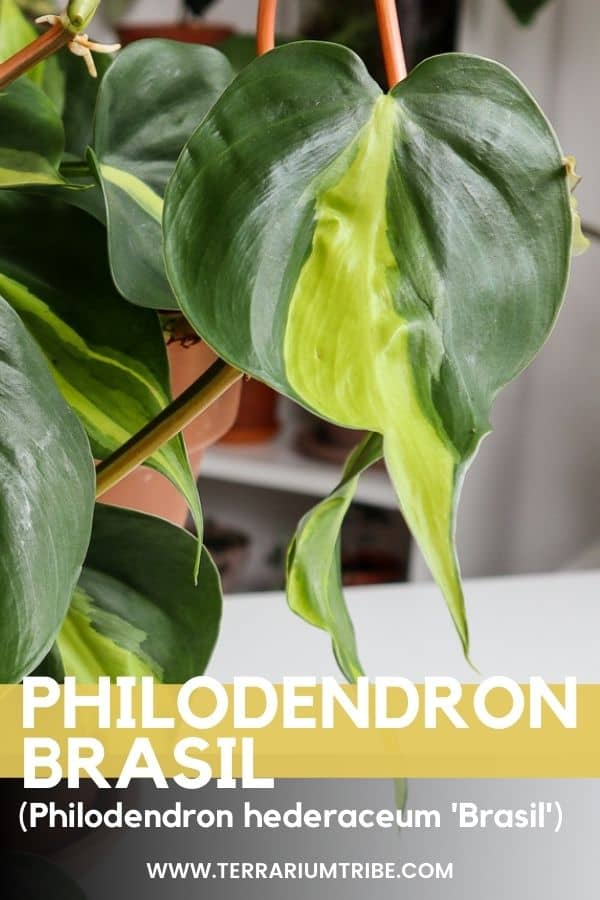
What is the Philodendron Brasil?
The ‘Brasil’ has all the simplicity of a hardy vine with all the beauty of a rare exotic wonder.
With the most gorgeous heart-shaped leaves and vibrant variegation, you won’t be able to stop yourself falling head over heels in love.
After being first discovered – in Brazil no less – in a controlled environment in 1991 (yes, she’s a millennial), this plant danced into the houseplant scene as a fantastic, easy-to-care-for option.
It only needs a little love and understanding for fast growth and healthy leaves.
So, without further ado, let’s get into the care guide!
Where to Buy Philodendron Brasil
See the links below to purchase from reputable terrarium plant shops and marketplaces (may include affiliate links).
Philodendron Brasil Care & Growth
At a Glance
| Plant Type | Vine |
| Lighting | Medium- bright indirect light |
| Temperature | 55-95°F 13-35°C |
| Watering | Evenly moist soil |
| Humidity | Medium humidity 60-80% |
| Growth | Up to 5ft vine |
Light
In nature, Philodendron hederaceum epiphytically climbs up the native trees while remaining beneath the dense jungle canopy, out of the way of the sun’s harsh rays.
So, to best mirror this in the home, we can strive for bright indirect light conditions.
What does indirect bright light even mean, you ask? Simply put, it is a bright spot that gets no direct beams.
Imagine your plant and the sun have eyes – they shouldn’t be able to make eye contact.
In low light, the plant might struggle to photosynthesize, and you could lose some of the bright variegation.
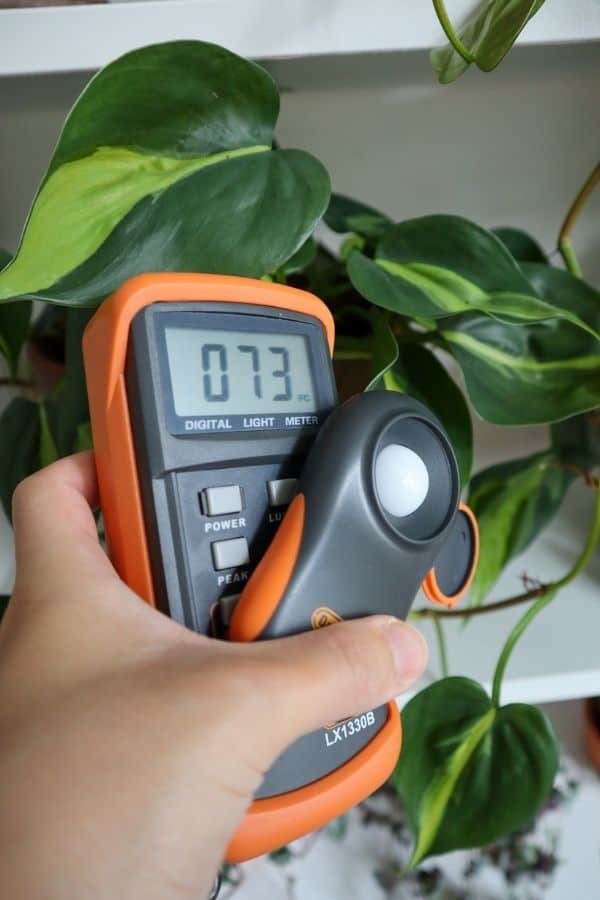
With direct sunlight, however, you’d likely see some scorching on the leaves, stems, and aerial roots. They turn a rusty red color and can even lead to leaf loss.
When we bought our Philodendron Brasil as a mature plant it had been sat in direct light and showed signs of a little sun damage (the aerial roots had completely crisped up).
These days, she flaunts her variegated leaves center stage on our plant-adorned bookcase around 10ft away from a south-facing window.
In the winter months, I’ll likely stick her under a grow light to keep those light levels up when the days get shorter.
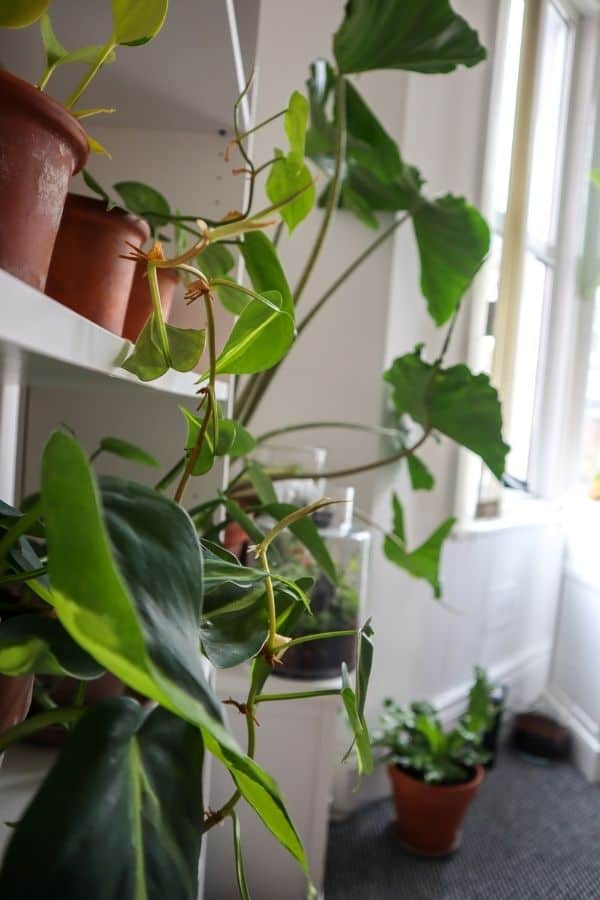
Watering
As the hederaceum hails from the rainforest, it’s no surprise that it likes moist soil.
But, while it loves moist soil – it detests soggy soil. I would, wouldn’t you?
This makes it extremely important to choose a pot with a drainage hole when growing indoors. If excess water doesn’t have anywhere to go, your roots could be sat in a wet mess, and you’d risk root rot.
If you’re not yet convinced, a drainage hole makes watering your plant a thousand times easier.
I soak my plant until I see water coming into the drainage tray and tip out the excess – that way, I know it’s not soggy.
I know it’s time to water it again whenever the top inch of soil has dried out a little. It’s that simple!
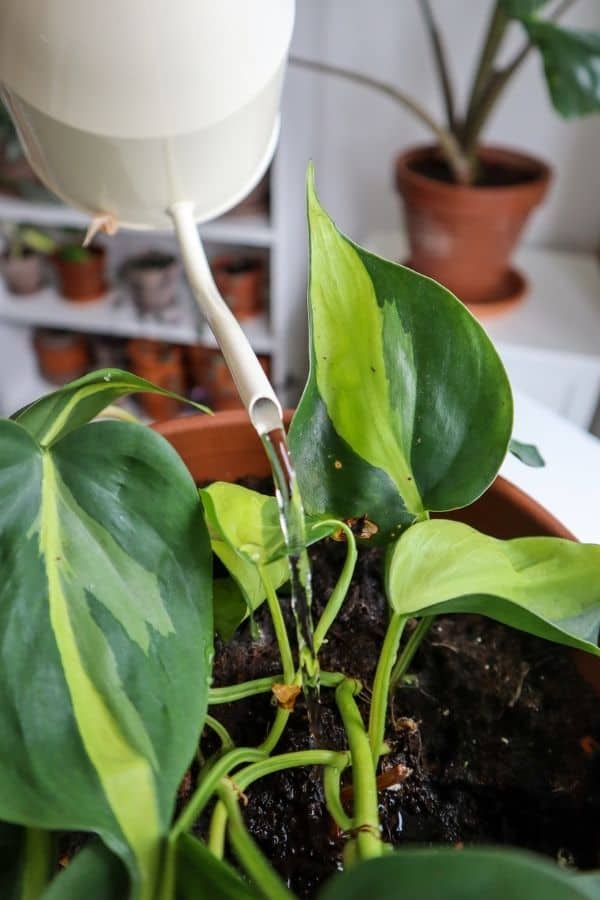
In a terrarium, you’ll want to create a generous water balance that ensures the substrate stays lightly moist at all times but never becomes saturated with water.
The roots want consistent access to moisture but still need to be able to breathe.
Substrate
Philodendron Brasil isn’t the pickiest plant in the world and would probably be fine in poor soil, but to thrive, it’s going to need something better than potting soil.
A chunky soil mix is going to be best. I like coco coir as a base (good for water retention) and then add in something like orchid bark and some perlite for aeration.
Works a treat.
As a houseplant, I’d recommend feeding the Brasil with a balanced liquid fertilizer every month or so, Philodendron tend to need more nutrients than you’d see with other tropical vines like Pothos.
In a terrarium, adding earthworm castings to the substrate is a genius way to add some slow-release nutrients right from the start, so you don’t need to add any extra water to the system in order to fertilize.
Temperature & Humidity
When the Brasil first blessed the world with its existence, it was originally grown under controlled conditions in Brazil and Florida.
After taking a peek at the original plant patent, I’m very happy to announce that there’s pretty much no temperature this plant won’t thrive in.
It was grown in the widest variety of temperatures – starting at a nighttime average of just 55°F (13°C). Being an average, we can assume it can tolerate even lower temperatures.
And in the summer heat, the plant was able to grow with highs of a whopping 95°F (35°C)!
If you keep your home at a temperature outside of that range, I doubt you’ll be able to keep any friendships alive, let alone plants…
But, I know giving such vast scales isn’t necessarily helpful, so for reference, our office (where we keep all of our tropical babies) typically hovers between 73-80°F (23-27°C) and has around 70% humidity on average.
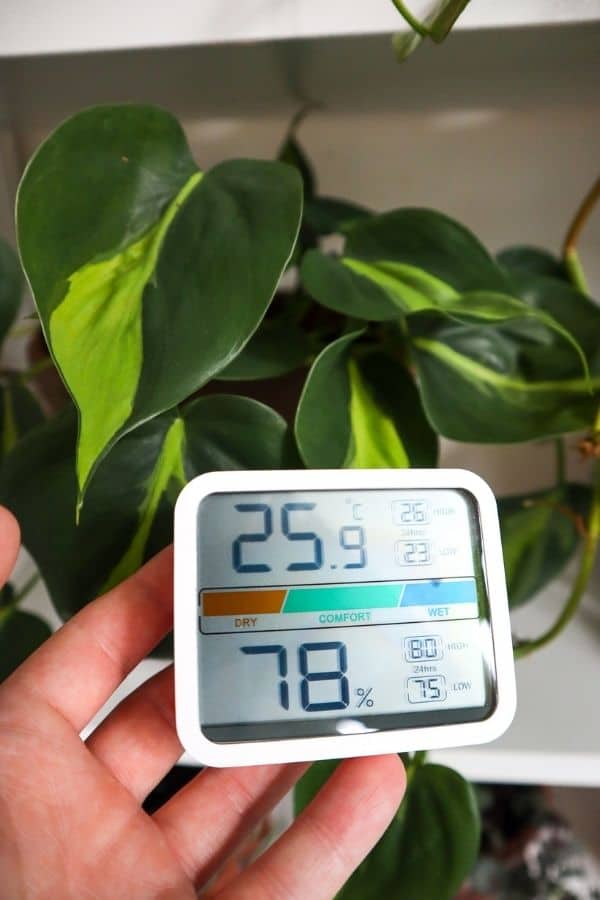
When it comes to humidity, tropical plants want tropical conditions.
Basic household humidity should be okay for the Philodendron Brasil, but it’ll prefer something in the 60-80% range ideally.
So, if that’s something you’d struggle to achieve, it might be worth getting a humidifier, popping it in a terrarium, or getting MORE plants and keeping them all together (as if you needed an excuse).
Growth
Climbing the rainforest trees, this majestic vine can even reach 20ft tall in the wild!
Mental right? I really struggle to wrap my head around those kinds of heights…
As an indoor plant, she can get pretty long, too. I’ve seen some plants reaching around 5ft, but I imagine it would take quite a few years of growth to get those lengths.
You’ll need to decide whether you want her trailing or climbing, and then either place her somewhere high or give her something to go up, like a moss pole.
I’ve even seen people on Pinterest training their Philodendron to climb the walls (presumably with pintacks), and it looks utterly marvelous.
If you’re less into leggy vines and prefer a fuller look, regular trimming will help promote a bushier growth habit. And it’ll provide even more cuttings to propagate, which you can plant back into the mother plant, which will make it even bushier!
The cycle continues – hurrah!
In a terrarium, you’ll need to have your scissors at hand to prune her back when she gets a little out of hand, but she’s otherwise very suited to terrarium life.
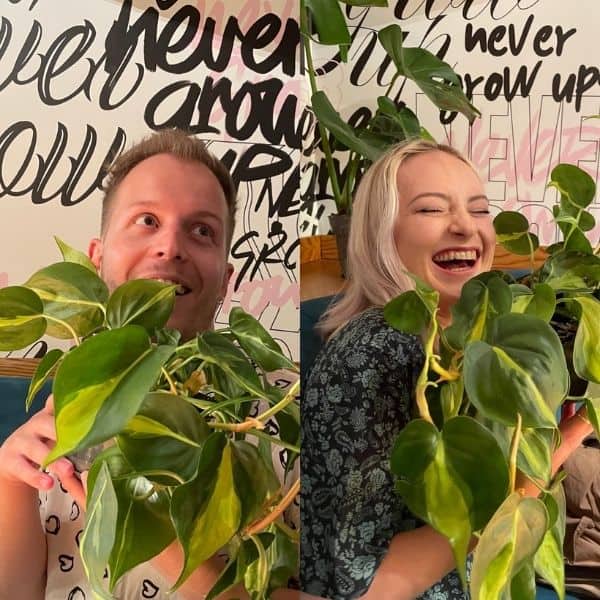
Propagation
You don’t need to be a green-fingered houseplant champion to propagate the Brasil – it’s easily done by a simple stem-cutting process.
All you need is a jar of water and the caffeine-induced confidence to get trigger-happy with the secateurs.
I like to wait until my vine is nice and long and do several cuttings at once.
Snip beneath the root node (so you have a node and a leaf per cutting) and whack your cuttings in water.
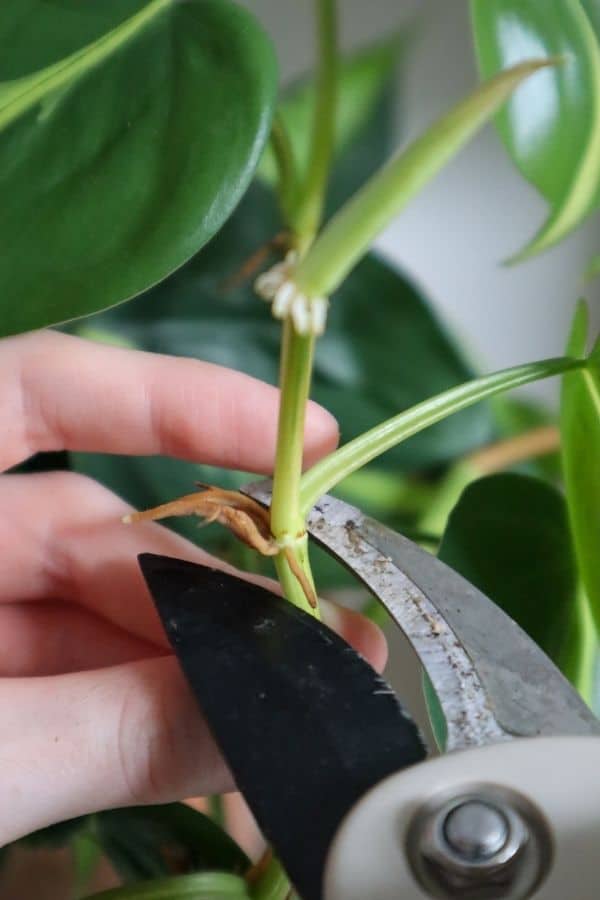
Then simply sit back and have patience, dear child…
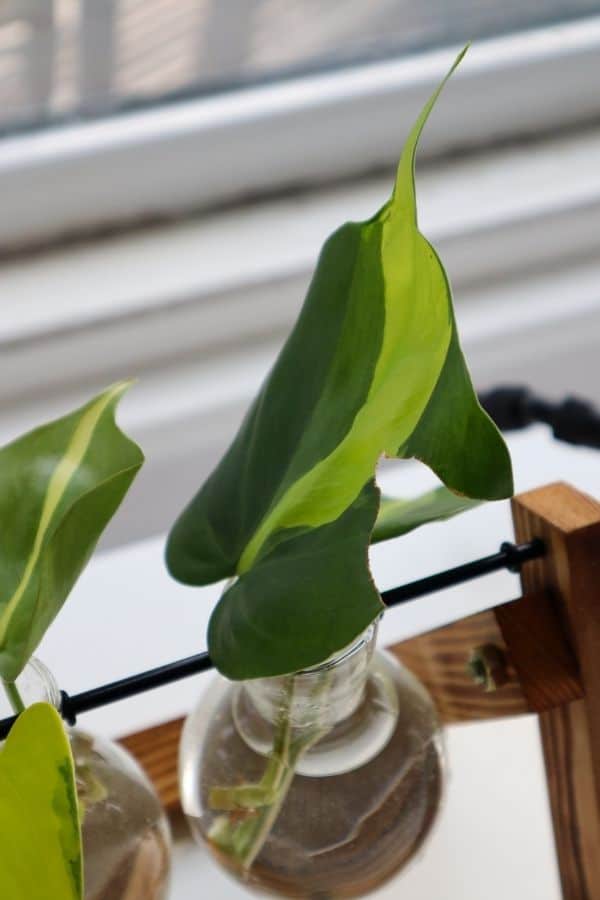
In a few weeks, you’ll have roots. Then either plant it back into the mother plant, pop it in your new terrarium project or give the gift of plant life to a loved one.
Easy-peasy.
Varieties and Similar Plants
There are so many beautiful Philodendron hederaceum to collect:
- Heartleaf Philodendron – the clean green heart-leaf, a truly classic houseplant.
- Philodendron Lemon Lime – which shares the same zingy color as the Neon Pothos.
- Philodendron Rio – the Brasil 2.0 with an amazing stripe of silver and cream variegation as opposed to light green (and yes, she dances on the sand).
- Philodendron Gabby – Creamy colored leaf with green variegation in the center.
- Philodendron Cream Splash/ Philodendron Silver Stripe – Pretty much just a Brasil with different variegation tones. They’re extremely similar, quite unstable, and potentially even genetically the same – it’s a little like the Marble Queen Pothos/Snow Queen Pothos debate.
And, while we’re at it, the luxurious velvety Philodendron Micans is technically a hederaceum, too!
Finally, if you’re after a more compact plant (e.g. for a terrarium), check out the Philodendron Birkin.
Frequently Asked Questions
The Philodendron Rio has silver and cream variegation (in the middle of the leaf), whereas the Philodendron Brasil has lime green variegation. The Rio’s leaves can be more elongated than heart-shaped, too.
Misting your Philodendron Brasil is unlikely to do anything for your plant. Misting doesn’t increase humidity for long, so it’s a better idea to increase the humidity levels in the home. A good trick is leaving full watering cans around the room.
Your Philodendron Brasil not growing could mean any number of things, but it’s more likely to be a lack of light or adequate water than anything else.
Your Philodendron Brasil could be turning pink/red for several reasons. Bear in mind that it’s perfectly normal for new leaves to come in with a peachy-pink color before they turn green. But more redness than usual can be something more sinister, too. Commonly, it’s scorched by too much direct sunlight, but it could be an issue with under-watering or fertilizer.
Yellow leaves on your Philodendron Brasil can be a sign of inconsistent watering – either underwatering or overwatering, but more likely the latter. It’s normal for your plant to sacrifice older leaves to prioritize new growth, though, so as long as it’s pumping out new leaves, then it’s probably nothing to worry about.
Too much or too little water can lead to Philodendron Brasil leaves drooping. You’ll likely need to adjust your watering schedule a little so that your plant isn’t sat in soggy soil and isn’t left dry too long. And always, always have a pot with a drainage hole.
